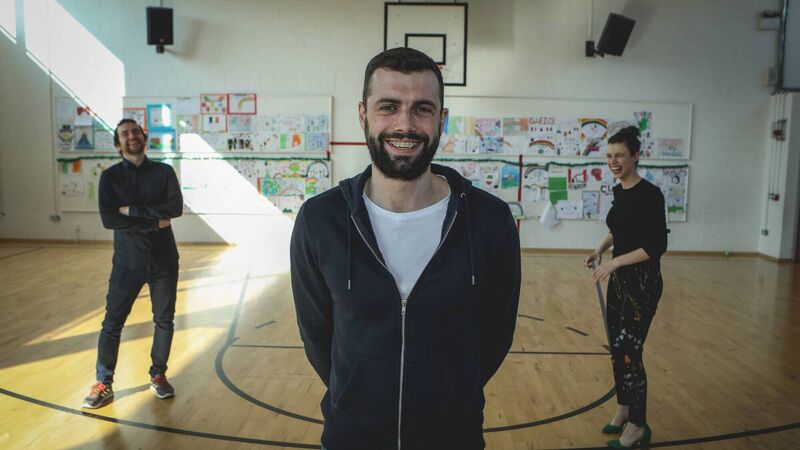Muinteoir John: Putting fun back into the learning of Irish

John Sharpson from RTE's Home School Hub says children are now seeing their favourite influencers, YouTubers and presenters speaking Irish online and on television, and are being inspired.
The topic of children learning mandatory Irish has been a controversial one for quite some time, deservedly so possibly.
For years people have turned their noses up at ‘the Gaeilge’ and asked the question: ‘How can a child go to school, learn a language for 14 years and leave the school not being able to speak it?’
And let’s be honest this is a valid question.
For many pupils learning French, Spanish or German in secondary school for a total of only five to six years has resulted in them having a better grasp of European languages than our own national language as they walk out through the school gates for the last time.
Indeed, anyone who is against the idea of mandatory Irish will tell you that it is not learned correctly ‘because it is not taught correctly’.
There is a chance that this was true ‘fadó fadó’ but in my teaching experience this is no longer the case.
There is a huge emphasis put on ‘oral language’ in the present-day classroom due to the revision of the primary language curriculum. This is because realistically children cannot write what they cannot say.
Since the revision of the language curriculum the Irish language is now spoken, sung, and shouted within the classroom walls in the form of dramatic plays about puppies that get lost in the park, poems being recited complete with hilarious actions and songs about the important things in a child’s life: breakfast cereal or choosing a new instrument from the music shop.
As languages go the Irish language has been through the wringer. That’s actually putting it lightly. As languages go the Irish language has been through 10 rounds with Katie Taylor.
The majority of Irish was spoken in the West of Ireland and when the famine decimated the population in the 1800s, many people from the west either perished or left the country on coffin ships in the hopes of a brighter future. The Irish language suffered greatly as a result.
As if that wasn’t enough, the British occupation in Ireland tried everything in its glorious imperial power to bring about its extinction through the introduction of their penal laws.
Despite all of this the language has survived. How? Through good ol’ fashioned Irish stubbornness.
Winston Churchill once said “We have always found the Irish to be a bit odd. They refuse to be English!” and because of teachers risking prosecution in their hedge schools to ensure the survival of the language back then, we now still have a beautiful language and furthermore, we are now in a position to teach it as something engaging, fun, and something to be proud of.
Social media has played a huge part in the promotion of Irish in recent years and it is only going from strength to strength.
Children are now seeing their favourite influencers, YouTubers and presenters speaking Irish online and on television, and are being inspired.
Gaeltachts and Coláistí Samhraidh up and down the country are living proof the language is very much alive and being used and enjoyed by the youth.
After all, what better reason is there to learn a language other than to be able to ask someone to dance at a ceilí?
It seems the ‘should Irish be mandatory?’ debate is being diluted slowly but surely. However, there are still children who ask teachers why they are learning Irish. These children did not lick this opinion off a stone.
Personally I have even had one child shrug his shoulders at me as he casually explained that it is a ‘dead language’ and he ‘doesn’t see the point’. I should add that I can hear his father’s inflection as the child is saying this to me.
This attitude is not uncommon. There are members of the older generation who have not had a good experience of Irish in school. Some look back on their experiences with regret, but some have resentment towards the language as a result of their own experiences.
If they decide not to pursue Irish after school that is completely their choice but I do know that if they are encouraged from home during their school years they will enjoy learning their national language, that’s a ‘Múinteoir John’ promise.
Children love hearing the history of the language and stories of Cú Chulainn and how he got his name. They ponder at how Dublin should be called Black Pool (Dubh Linn).
They giggle at the fact that a jellyfish as Gaeilge is a smugairle róin which means seal phlegm and above all they want to start learning their cúpla focail straight away.
It's important not to be too hard on ourselves for not having beautiful, free-flowing, fluent and grammatically correct Irish. The more I think about it, I don’t even have that level of fluency in English.
However, it’s also important to remember the old saying ‘Is fear Gaeilge briste ná Béarla cliste.’
So pick up a few words for Seachtain na Gaeilge 2021 agus bain taitneamh ás.













